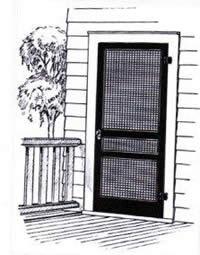 March 21, 2025 - More often than not in times past, the gentle buzz of a summer evening led to the furious scratching of a sleepless night. Humans have fought the good fight between insects and fresh air with solid shutters, leather door drapes, and the misery of sweat-soaked bedding, but science and surplus revolutionized door and window treatments with the wire mesh screen.
March 21, 2025 - More often than not in times past, the gentle buzz of a summer evening led to the furious scratching of a sleepless night. Humans have fought the good fight between insects and fresh air with solid shutters, leather door drapes, and the misery of sweat-soaked bedding, but science and surplus revolutionized door and window treatments with the wire mesh screen.
If you were born prior to 1950, you probably remember when all home doors and windows had screens installed. I still remember the screen doors that were on all the exit doors of my grandfather’s modest home. Prior to modern air conditioning there was no other way to cool the inside of a home than to open all doors and windows. This activity also invited all kinds of flying insects and bugs to also enter, especially the mosquitoes.
Around 1900, Dr. Walter Reed discovered the fact that mosquitoes carried the yellow fever disease, so a massive eradication and education program was initiated in the Panama Canal as well as the United States. This included the installation of screen windows and doors.
Americans had window screens before the scientific breakthrough that changed the way people thought about and prevented common, deadly diseases. Windows and doors were covered in cheesecloth to let the air circulate but keep out flying critters and airborne dirt. However, cheesecloth wasn’t very elegant, and it definitely wasn’t durable, but it did make a hot summer night bearable.
Then the civil war came. Fine wire mesh was manufactured in the mid-18th century to make flour sieves and screens for cheese manufacture. The Gilbert and Bennett sieve-making company in Connecticut quickly accumulated a surplus of wire mesh because they could no longer sell in the Southern states. But, a clever employee slapped some gray paint on the mesh to coat it against rust, and then started selling it for window and door screens.
The “American Farmer” periodical advertised “wove wire for window and door screens” as early as 1823, and an 1839 exhibition of two wire window screens at Boston’s Quincy Hall was designed to popularize the novel concept. But it wasn’t until the Civil War intervened that wire screens were added to most houses and porches. Early 20th century homes featured removable summer screens for all opening windows and doors, and the screened sleeping porch was a retreat for the whole family when the temperatures rose.
Eventually, air conditioning turned the sleeping porch into a quaint artifact, and space-challenged families renovated their neighborly screened porches into enclosed sun rooms. But, the window and door screens survived. It’s still an important defense against sharing your space with everything that creeps, crawls, flies, and bites when the windows are open.
My grandfather’s home had two front doors, both of which had screen doors. These doors were made of wood frames with wire mesh installed from top to bottom. A twelve inch long spring was attached to the inside middle of the door, then stretched and attached to the inside door frame. Thus, when the door was opened, the spring would pull the door back shut. I can still remember the noise that the screen door would make when opened and shut. You will get to hear the best summer sound of all, the squeal of a hinge spring followed by the distinctive slap of a wood door hitting its stop.
Soon warm evening breezes will fill the air, crickets will chirp, and sweet-scented flowers will bloom. And that will mean it’s time to fling open the door and enjoy summer’s delights. Just be sure that there’s a screen in place or you will have critters under the sofa.








